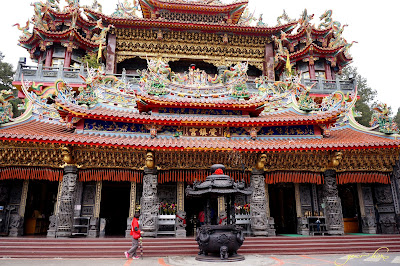 |
| Alishan Gou Hotel |
 |
| Alishan Gou Hotel |
Past the hotel is an entrance to the trails. A map of the area is available here.
 |
| Area Map |
 |
| The Sister Pond |
|
|
 |
| Love Forever Two old Taiwan red cypress stumps have naturally grown intertwined with their roots, developing into a big heart shape. The intriguing shape has been interpreted as a symbol of eternal love. |
 |
| Downhill path to Magnolia Garden |
 |
| Magnolia Garden Magnolia trees belong to Magnoliaceae. They are one of the existing and more primitive families in plant evolution. One characteristic of the magnolia is its heady scent. The magnolia belongs to a type of deciduous trees with extremely large, six petal blossoms. In spring, the blooming flowers are at their most vivid and brilliant stage. There are white and purple species mixed in this area. |
 |
| Magnolia Garden |
Continuing on to the trail, I reached Shouzhen Temple. It is the largest temple within the Alishan area and indeed, it is also the highest altitude temple in Taiwan (2150m). Since the reconstruction in 1969, it has become one of the most popular temples for the locals. (Source: Sinotour)
 |
| Wasabi plant sold around the temple |
 |
| Shouzhen Temple |
 |
| Around Shouzhen Temple |
|
|
 |
| Stump Looks like Elephant's Trunk Look closely at this aged red cypress stump. Can you see that the shape of the stump is similar to an elephant's head, eyes and trunk? If you think the stump is exactly the same as an elephant, take a snapshot with the stump. You may find it more like a mammoth because it covers a large layer of mosses. |
 |
| A school within the forest |
 |
| Alishan Museum Alishan Museum was built in 1911. The museum constructors mainly adopted Taiwan cypresses as the construction materials. Displays in the exhibition hall of the museum include various alpine animals and plant specimens, forest management planning, as well as aboriginal costumes and the cultural heritage of the Tsou Tribe. |
 |
| At Cihyun Temple |
|
|
 |
| Thousand Year Cypress |
 |
| Alishan Sianglin Sacred Tree To pass down the legacy of the now fallen Alishan Sacred Tree, the Forestry Bureau, Chiayi County Government, and the Tourism Bureau co-organized the "Balloting Campaign for Alishan Sacred Tree II," through which this giant tree received most votes and was thus given the name "Alishan Sianglin Sacred Tree" on January 1, 2007. |
 |
| Giant Trees Boardwalk - 1 Giant Trees Boardwalk one is about 600m in length. It was built for conservation of the ecosystem using elevated boardwalks such that people will not trample on the soil and roots, and the precious giant trees can be protected. Along the path you will encounter the 20 remarkable giant trees. |
After almost 2 hours of walking, I got to the Sacred Tree (Shenmu Station). I was happy I got there before 4PM, that means there's still a train going back to Alishan Station. It was also a relief I took the Alishan-Zhaoping-Sacred Tree-Alishan route, as the path from Zhaoping Station to Sacred Tree is mostly downhill. Had I done it the other way around, I would have sore legs and might not even be able to catch the last train from Zhaoping Station.
 |
| Down to Sacred Tree Station |
Additional information on Alishan is available in the wikitravel site and here.










ni hao..very detailed information of Alishan=)
ReplyDeletexie xie... hope the information helps :)
DeleteI love Taiwan. Didnt expect much that it would be an amazing country to visit. Alishan looks nice in the photos, unfortunately, I didnt have enough time to go there. I'd definitely include this in my itinerary next time I visit Taiwan.
ReplyDelete